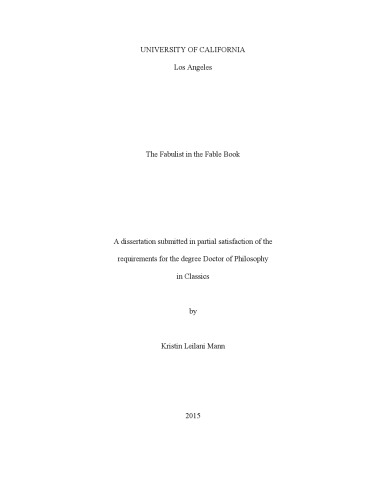Product desciption
The Fabulist In The Fable Book Thesis Kristin Leilani Mann by Kristin Leilani Mann instant download after payment.
Four fable books survive from Greco-Roman antiquity: (1) the Life and Fables of Aesop (1st-2nd century CE), a collection of Greek prose fables; (2) Phaedrus’s Fabulae Aesopiae (1st century CE), a collection of Latin verse fables; (3) Babrius’s Μυθίαμβοι Αἰσώπειοι (1st century CE), a collection of Greek verse fables; and (4) Avianus’s Fabulae (4th-5th century CE), a collection of Latin verse fables. The thesis of this dissertation is that in each of these fable collections, the fabulist’s presence in the fable book – his biography, his self-characterizations, and his statements of purpose – combine to form a hermeneutic frame through which the fables may be interpreted. Such a frame is necessary because the fable genre is by nature multivalent: fables may be interpreted in many different ways, depending on their context. For embedded fables (that is, fables embedded in a larger narrative or speech), the fable’s immediate context influences the fable’s interpretation. In the fable books, however, there is no literary context; the fables stand as isolated narratives. The fabulist himself, I argue, takes the place of this missing context, and thus provides the reader with an interpretive framework. Such a framework does not outright control the interpretation of the fables (the fables remain multivalent), but it does provide a field of plausible interpretations. Furthermore, because each fable book has a different hermeneutic frame, each text is unique, despite using much of the same material. Thus, in the Life and Fables of Aesop, the Life serves as a guide for how to use the Fables that follow, a guide that is aimed at low or powerless individuals. Phaedrus’s collection demonstrates the usefulness of fables as a form of coded speech, for slaves and for other disempowered individuals. Babrius’s collection explores the usefulness of fables in education, and teaches the readers how to think about and apply fable wisdom correctly. Finally, Avianus’s fable collection is concerned not only with the boundaries of genre – with what is and is not appropriate for the fable genre – but also with the nature of display and ornamentation itself, an important issue in late antique culture. These four fable books have not, on the whole, received much scholarly attention, and there has been little attempt to read them as coherent works of literature in their own right. By considering the overall purpose and hermeneutic frames of each of these collections, this dissertation fills an important gap in scholarship.


